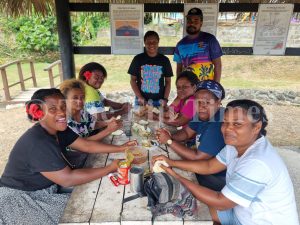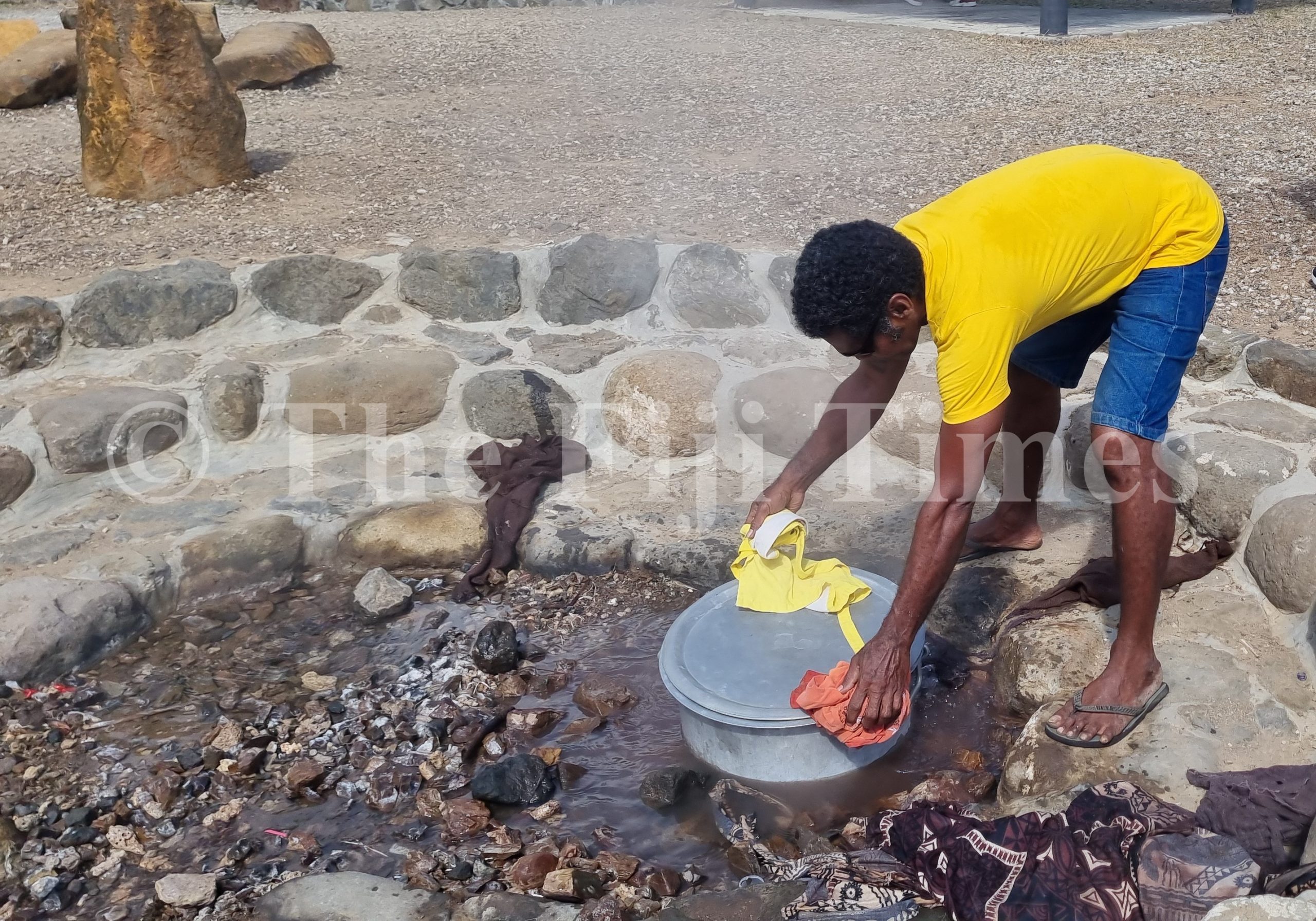When Europeans settled in Fiji in the first half of the 1800s, they were told by indigenous Fijians that the Nakama hot springs in Savusavu had been around since time immemorial.
And for generations these geothermal ovens have been used for a variety of reasons, chief among them – cooking food without a single spark or flame.
This week, The Sunday Times team visited Nakama with the intention of cooking a simple breakfast and trying out what Savusavu residents have been doing for many years.
For three dollars, a taxi took us and our breakfast shopping from town to a section of the hidden paradise called Nakama Road.
The road to the springs also led to the three-star Hot Springs Hotel which perched idyllically from a towering height. Both hot springs enjoyed the best views of the crystal-clear harbour.
It was from a picturesque place like this that we found a welcome respite, in between interviews and a scheduled bus ride to Buca Bay.
“You haven’t been to Savusavu if you haven’t been to these hot springs,” our taxi driver confessed as we approached the tourist attraction.
“If I were you, I’d cook something in the hot pools, you know… just to get a feel of what we’ve enjoyed for some time.”
Little did the driver know that juggling restlessly in my red shopping bag were eggs, tea buns, sachets of Tang juice, a bottle of icy cold water and a tin of Watties baked beans.
By the time the taxi ground to a halt at our destination, a pot of something was already sitting in one of the pools, draped with brown sack to trap the heat and weighted down with a stone.
In another pool, a few women had just dropped in a bag of breadfruits, to be eaten later with tinned fish in tomato sauce and onions.
With the sweltering sun slowly making its westward journey above us, we headed straight to one of the site’s three thatched sheds and got ready for breakfast.
The place was a far cry from yesteryears, when the springs were largely ignored and left unkempt.
Today, they look smartened up with landscaping, stone walls, signage, steps and drains around the springs. Three open-sided bures afford shade and seating for visitors, and a series of signs explains the geology behind the springs.
According to historical records, in 1864, the first scientific description of the Savusavu hot springs was noted by the prominent American geologist, James D. Dana.
His commentary was based on information provided more than two decades earlier by members of the United States Exploring Expedition that did a surveying exploration of the Pacific Ocean between 1838 and 1842.
Dana observed that the springs were made up of five boiling springs with jets of water described as “boiling fountains”.
In 1876, Constance Gordon-Cumming, a Scotland-born female travel writer and artist, was invited to travel to Fiji with Lady Gordon and her husband, Sir Arthur Gordon, who had been appointed the first governor after Fiji’s cession to Britain in 1874.
Gordon-Cumming mentioned “three springs with intermittent fountains” in her writings. The height of the springs was observed to be between 60 and 90 cm, and they spewed jets of hot water every 20 minutes.
In 1878, John Horne, a Scottish botanist who was selected as part of a group of officials who accompanied Sir Arthur Gordon to Fiji, said the jets of boiling water were up to 30 cm high.
Twenty years later, in 1898, H. B. Guppy, a British surgeon, geologist, botanist and photographer, said Savusavu’s hot springs behaved like true geysers – spouting 12 to 18 metres high for intervals of 10 to 20 minutes with a silent period in between.
This phenomenon lasted several months before the hot springs returned to their normal bubbling.
In 1958, 3 km NNE of Savusavu town, three to four water spouts up to 30 metres in height, occurred for a period of several hours while in 1961, about 8 km due west of the town, four or five columns of water and steam rising from the sea to a height of 15 metres were observed over three consecutive days.

“The activity took place intermittently for periods exceeding 2 hours with individual water columns lasting 10 to 15 minutes,” Savusavu Hot Springs history literature noted.
“The cause of this phenomenon is unknown as there was no seismic (earthquake) activity recorded at the time or any other known reason for these springs to suddenly erupt from the floor of Savusavu Bay.”
In the same year, small experimental plants for producing salt by the evaporation of sea water using surface geothermal heat were tested near the Nakama hot springs and produced a satisfactory salt which contained 97 per cent sodium chloride.
For many years now, the hot springs have failed to spout to the great heights described in the writings during colonial times.
Sometimes, the pools go almost dry for a minute or two before filling up again, as if an angry monster inhales and exhales from underneath the earth.
The Sunday Times team’s eggs were cooked within 10 minutes and came off the sizzling pool before breadfruits, puddings and beef pieces were removed.
“Savusavu residents are lucky to have these hot springs but they need to keep it clean at all times,” said Ratu Kamikamica.
“We use them to boil root crops and other food that take a while to cook, such as meat, and ivi. They save us power and money and are important for our tourism.”
The hot springs at Nakama are not only free to use, they also provide an economical option to cooking with fuel and are friendly to the environment.
Local villagers have used this geologic wonder for years as a natural cauldron to cook dalo, fish and even cakes.
With its new makeover thanks to the assistance from the Commonwealth Local Government Fund, Nakama hot springs have become the town’s only true natural tourist attraction.
“Walking along the foreshore, visitors can see many vapors rising from roadside, creating a misty fairy landscape,” the springs’ public information literature says.
The hot pools, springing from deep under the earth’s crust, deserve to be the Cakaudrove town’s premier attraction.
In fact, a handful of eateries in Savusavu town rely on the springs to offset their cooking fuel costs.
“I brought a pot of pudding for boiling and it should be cooked within three to five hours,” a visitor told the team.
“I come to steam our puddings at the pools almost every day. It’s a clean way to cook and saves energy and money.”
Three Yokes Café, one of Savusavu’s innovative business ventures, owned and run by Naivuatolu Community Cooperative, has been making use of the hot springs to cook one of its most popular dishes – beef meaty bone soup called sui.
“Three Yoke’s Café’s soups and stews are beloved in Savusavu, their rich flavors and tender meat are created by slow cooking them over the nearby Savusavu hot springs,’ an online article on the café noted.
The use of the natural springs to cook fits in well with café’s philosophy on creative and sustainable entrepreneurship.
Aside from eateries, many families rely on the hot springs for their dinner or as a “last resort” when the gas or kerosene stove runs out at home.
“I’ve cooked here a number of times. I just buy staple food from the market, like vudi and tivoli, put it in a sack over the springs and pick the food up a few hours later,” Sera Dautau said.
“The springs mean we will always have free cooking facility. We are so blessed to have them.”
In 2019, a bathymetric survey of Nakama creek indicated eight undersea hot springs close to Nawi Island. Surveys are yet to be undertaken to determine whether these springs are active or dormant.
Furthermore, there are other hot springs located close to the towns of Labasa (Tabia, Batinikama and Waiqele) and Savusavu (Rava and Nukubolu), and in several other places including Cogea in Bua.
However, Savusavu is the most active geothermal locality among all hot spring sites in Fiji.
Experts say there are three major fault lines close to Savusavu. These fault lines allow water to soak to depths where it is heated geothermally and emerge as hot springs.
History being the subject it is, a group’s version of events may not be the same as that held by another group. When publishing one account, it is not our intention to cause division or to disrespect other oral traditions. Those with a different version can contact us so we can publish your account of history too — Editor.



